The Paired Grain Persian Revision
Periodically, in Biology, as new discoveries and new information are uncovered over time, taxonomic revisions are made. I see no reason why a similar "structural revision" could not be applied to chainmaille. Much like its biologic counterpart, this structural revision will focus on identifying and structurally naming all the weaves within that group, determining their relationships to each other, and classifying them according to their shared characteristics.
Naming Note: I have no interest (in most cases) of trying to change any of the "commonly accepted" names of these weaves. As such, on this site at least, I will be introducing a field for "Structural Names". In cases of there being no current commonly accepted name for a weave, the structural name will be used.
The main subject of this revision will be, what I currently call, Paired Grain Persians. It will only include the base forms and not any modified versions (grizzly, oblique, x back, stacked, staggered, etc.) For the purpose of this revision, Paired Grain Persians will be examined as a Spinal Grain (parallel to X surface) and an Inverted Lock Grain. (perpendicular to X surface). Paired Grain Persians are made up of, as you might have already guessed, two paired grains (for a total of 4 grains per weave). In cases where the same paired grains are used for both the Spinal and Inverted Lock grains, that weave will be designated as the "base weave" for that subgroup.
Future Research: It's my belief that the concepts presented here can also be applied to, (at the very least) other "Persian" weaves such as Half Persian, Three Quarters Persian, and Hilt. I have made some preliminary steps in said research, but more needs to be done before anything can be published.
This revision is largely possible due to the tireless work of Dave Austin ( C _CMB_ ), proprietor/collator of chainmailbasket.com, the most prolific listing of weaves on the internet. Without our conversations and his work into Full Persian 6 Cross Grains, this revision would not exist.
Naming Note: I have no interest (in most cases) of trying to change any of the "commonly accepted" names of these weaves. As such, on this site at least, I will be introducing a field for "Structural Names". In cases of there being no current commonly accepted name for a weave, the structural name will be used.
The main subject of this revision will be, what I currently call, Paired Grain Persians. It will only include the base forms and not any modified versions (grizzly, oblique, x back, stacked, staggered, etc.) For the purpose of this revision, Paired Grain Persians will be examined as a Spinal Grain (parallel to X surface) and an Inverted Lock Grain. (perpendicular to X surface). Paired Grain Persians are made up of, as you might have already guessed, two paired grains (for a total of 4 grains per weave). In cases where the same paired grains are used for both the Spinal and Inverted Lock grains, that weave will be designated as the "base weave" for that subgroup.
Future Research: It's my belief that the concepts presented here can also be applied to, (at the very least) other "Persian" weaves such as Half Persian, Three Quarters Persian, and Hilt. I have made some preliminary steps in said research, but more needs to be done before anything can be published.
This revision is largely possible due to the tireless work of Dave Austin ( C _CMB_ ), proprietor/collator of chainmailbasket.com, the most prolific listing of weaves on the internet. Without our conversations and his work into Full Persian 6 Cross Grains, this revision would not exist.
What is an Inverted Lock Connection?
An inverted lock connection is one of the four, currently recognized, connections in Cellular Chainmaille Theory. For the purpose of explaining how CCT differentiates connections, each ring will be shown in 2 halves (A/B or C/D).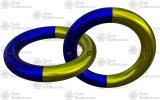 This is a Root Cell. Root Cells are made up of two rings (when unmodified in any way). Ring 2C connects to Ring 1B.
This is a Root Cell. Root Cells are made up of two rings (when unmodified in any way). Ring 2C connects to Ring 1B. This is a direct connection between two root cells. Cell Two (3A) connects to Cell One (2D)
This is a direct connection between two root cells. Cell Two (3A) connects to Cell One (2D) This is an inverted connection between two root cells. Cell Two (3A) connects to Cell One (2C).
This is an inverted connection between two root cells. Cell Two (3A) connects to Cell One (2C). This is an inverted lock connection between two root cells. Cell Two (3A) connects to Cell One (2C) AND Cell Two 4D is rotated and "locked" into place inside Cell One - Ring 1.
This is an inverted lock connection between two root cells. Cell Two (3A) connects to Cell One (2C) AND Cell Two 4D is rotated and "locked" into place inside Cell One - Ring 1.Weaving Note: When extending a chain, each extension (XA) will connect to the previous cell (XC) AND (XD) rotated and "locked" in place inside the previous cell - Ring X.
What Are Grains?
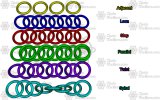 Grains are an evolution in thinking about the concept formerly known (on this site) as Precursors. Many of the grain types are identical to their precursor ancestors, but the way they are used has changed (and possibly their names). While not all precursors are currently considered grains, the status of the missing ones are still under consideration. The other main difference between precursors and grains is that grains will be used as a means of classification. Most grains are unstable piles of unconnected rings until stabilized in their pattern by the addition of a second grain.
Grains are an evolution in thinking about the concept formerly known (on this site) as Precursors. Many of the grain types are identical to their precursor ancestors, but the way they are used has changed (and possibly their names). While not all precursors are currently considered grains, the status of the missing ones are still under consideration. The other main difference between precursors and grains is that grains will be used as a means of classification. Most grains are unstable piles of unconnected rings until stabilized in their pattern by the addition of a second grain.Paired Grains
Grains can currently be paired in two ways:- Mirror - Reflection of a grain.
- Layered - Translation of a grain.
Lean
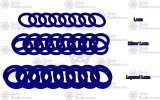
Step
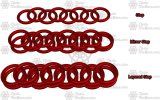
Twist

Spiral
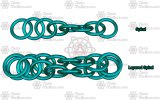
This above is not, by any means, an exhaustive list of grains, but only those currently recognized as such.
Why are some grains not relevant?
Adjacent grain - not relevant because it is not possible to use adjacent grain with inverted lock connections and remain an adjacent grain. Adjacent grains used with inverted lock connections will become a lean or step grain.
Parallel grain - not relevant because while technically possible (at least as a spine grain), Mirror or Layered Parallel is outside of the scope of this revision. A truncated version (missing a layer of rings that would make it a mirror/layered parallel) can be seen in the weave Two and a Half Persian. This form of the grain would simply be called Parallel 5 (because it is made of 5 layers )
)
Mirror Spiral - not relevant because it is my current belief that within the confines of a Paired Grain Persian a true mirror spiral cannot be used. If you can connect the following Mirror Spiral grain with paired inverted locks, while maintaining the Mirror Spiral grain, please contact me!!!
Parallel grain - not relevant because while technically possible (at least as a spine grain), Mirror or Layered Parallel is outside of the scope of this revision. A truncated version (missing a layer of rings that would make it a mirror/layered parallel) can be seen in the weave Two and a Half Persian. This form of the grain would simply be called Parallel 5 (because it is made of 5 layers
Mirror Spiral - not relevant because it is my current belief that within the confines of a Paired Grain Persian a true mirror spiral cannot be used. If you can connect the following Mirror Spiral grain with paired inverted locks, while maintaining the Mirror Spiral grain, please contact me!!!

Structural Note: Mirror or layered Adjacent or Parallel grains result in the same respective results.
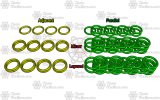
Filling In the Blanks
Commonly accepted names will be in parenthesis. Cells link to the associated Maillepedia entry. "Redundant" entries are marked as such because they have already been named elsewhere in the table (see "grain switching redundancy" below). There are a total of 28 different paired grain persians.
What's The Point?
As I asked myself many times while I was doing this, you may have also asked yourself "What's the point?" The main reason is consistency. If you look at the above chart, you'll see Full Persian used all over the place. If they're all Full Persian, then why have some been assigned different names? As they're all grain morphs, they could all just as validly be called Yucca, Twisted Persian or Two Hour Less Sleep variants. If one, or more, of them are worthy of different names, because they are different weaves, then shouldn't all of them be worthy of different names? By revising these Paired Grain Persians we get consistency of naming as well as consistency in what makes them different from each other.
The below sub groups are shown in order of seniority. You will notice that there are less entries in each group as you go down the list. This is due to grain switching redundancy. What this means is that as you move through the chart, you will come across weaves that have already been given names based on a senior grain present in the weave.
Grain Switching Redundancy: When using two different paired grains, spinning Paired Grain Persians 180 degrees and then rolling them 90 degrees will result in the grains switching places. The Spine grain becomes the Inverted Lock grain and the Inverted Lock grain becomes the Spine grain.
The below sub groups are shown in order of seniority. You will notice that there are less entries in each group as you go down the list. This is due to grain switching redundancy. What this means is that as you move through the chart, you will come across weaves that have already been given names based on a senior grain present in the weave.
Grain Switching Redundancy: When using two different paired grains, spinning Paired Grain Persians 180 degrees and then rolling them 90 degrees will result in the grains switching places. The Spine grain becomes the Inverted Lock grain and the Inverted Lock grain becomes the Spine grain.

Mirror Lean
Mirror Lean Grain was given seniority because, well, Full Persian Defining Grain: Mirror Lean
Defining Grain: Mirror LeanBase Weave: Mirror Lean Persian (Full Persian 6 in 1)
Number of Weaves: 7
Redundant Weaves: 0
Layered Lean
Layered Lean Grain is next in seniority because because it is the secondary way to pair a lean grain. Defining Grain: Layered Lean
Defining Grain: Layered LeanBase Weave: Layered Lean Persian (Half Persian 3 in 1 (Doubled))
Number of Weaves: 6
Redundant Weaves: 1
Mirror Step
Step grains are next because it is an alternating version of Lean grain.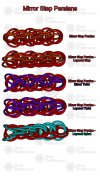 Defining Grain: Mirror Step
Defining Grain: Mirror StepBase Weave: Mirror Step Persian (One Hour Less Sleep)
Number of Weaves: 5
Redundant Weaves: 2
Layered Step
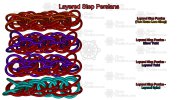 Defining Grain: Layered Step
Defining Grain: Layered StepBase Weave: Layered Step Persian (Two Hours Less Sleep)
Number of Weaves: 4
Redundant Weaves: 3
Mirror Twist
Twist is the next grain because it is actually two joined adjacent grains.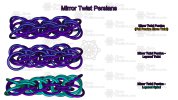 Defining Grain: Mirror Twist
Defining Grain: Mirror TwistBase Weave: Mirror Twist Persian (Full Persian Elven Twist)
Number of Weaves: 3
Redundant Weaves: 4
Layered Twist
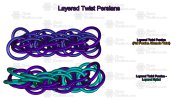 Defining Grain: Layered Twist
Defining Grain: Layered TwistBase Weave: Layered Twist Persian (Full Persian Alternate Twist)
Number of Weaves: 2
Redundant Weaves: 5
Layered Spiral
Spiral is the last grain because it is a further modification of twist grain. Defining Grain: Layered Spiral
Defining Grain: Layered SpiralBase Weave: Layered Spiral Persian (Full Persian Spiral)
Number of Weaves: 1
Redundant Weaves: 6
Please make sure to also read any updates to this resource here.
